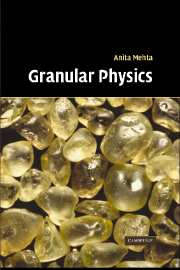Book contents
- Frontmatter
- Contents
- Preface
- 1 Introduction
- 2 Computer simulation approaches – an overview
- 3 Structure of vibrated powders – numerical results
- 4 Collective structures in sand – the phenomenon of bridging
- 5 On angles of repose: bistability and collapse
- 6 Compaction of disordered grains in the jamming limit: sand on random graphs
- 7 Shaking a box of sand I – a simple lattice model
- 8 Shaking a box of sand II – at the jamming limit, when shape matters!
- 9 Avalanches with reorganising grains
- 10 From earthquakes to sandpiles – stick–slip motion
- 11 Coupled continuum equations: the dynamics of sandpile surfaces
- 12 Theory of rapid granular flows
- 13 The thermodynamics of granular materials
- 14 Static properties of granular materials
- References
- Index
- Plate section
8 - Shaking a box of sand II – at the jamming limit, when shape matters!
Published online by Cambridge University Press: 06 October 2009
- Frontmatter
- Contents
- Preface
- 1 Introduction
- 2 Computer simulation approaches – an overview
- 3 Structure of vibrated powders – numerical results
- 4 Collective structures in sand – the phenomenon of bridging
- 5 On angles of repose: bistability and collapse
- 6 Compaction of disordered grains in the jamming limit: sand on random graphs
- 7 Shaking a box of sand I – a simple lattice model
- 8 Shaking a box of sand II – at the jamming limit, when shape matters!
- 9 Avalanches with reorganising grains
- 10 From earthquakes to sandpiles – stick–slip motion
- 11 Coupled continuum equations: the dynamics of sandpile surfaces
- 12 Theory of rapid granular flows
- 13 The thermodynamics of granular materials
- 14 Static properties of granular materials
- References
- Index
- Plate section
Summary
In this chapter we extend the model of the previous chapter in two different directions; the first and most important aim is to introduce long-range interactions with a view to obtaining properly glassy behaviour, and the second is to explore the role of grain shapes in granular compaction.
The model is based on the following picture. Consider a box of sand in the presence of gravity in the jamming limit. Adopting, as in the previous chapter, a lattice-based viewpoint, we visualise this box as being constituted of rows and columns of grains. When this box is shaken along the direction of gravity, the predominant dynamical response of the sandbox is known to be in the vertical direction – recall the on- and off-lattice computer simulation results presented in earlier chapters which show that correlations in the transverse plane (i.e. along rows of grains) are negligible compared to these. Another important aspect of the jamming limit is that grain-sized voids are typically absent. The dominant dynamical mechanism in this regime is therefore grain reorientation within each column to minimise the size of the partial voids that persist. We thus focus on a column model of grains in the jamming limit.
We now extend the concept of disorder to include the effect of grain shapes. Each ordered grain occupies one unit of space, while each disordered grain occupies 1 + ∈ units of space, with ∈ a measure of the partial void trapped by misorientation.
- Type
- Chapter
- Information
- Granular Physics , pp. 104 - 114Publisher: Cambridge University PressPrint publication year: 2007



